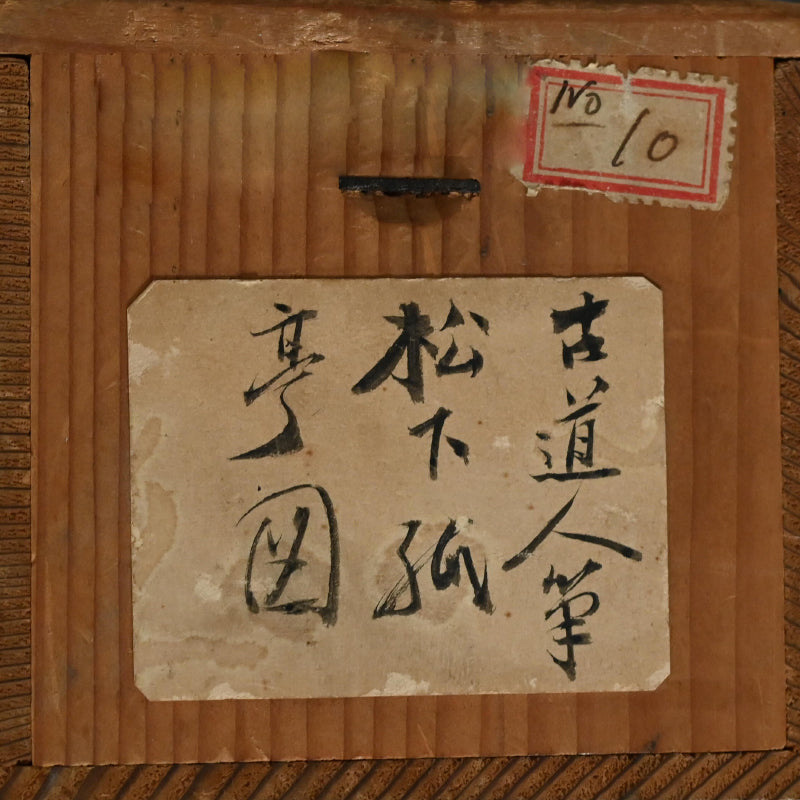Scroll Painting, Following the Wind ー福田 古道人 “松下孤亭図”
Scroll Painting, Following the Wind ー福田 古道人 “松下孤亭図”
Item Code: 古31
受取状況を読み込めませんでした
Rendered in a few spontaneous strokes of deep, fluid ink, the painting shows a thatched hut beneath a pine, its form distilled to abstraction. Within, a solitary figure—perhaps a recluse or sage—is indicated by a few lines and a faint touch of cinnabar on the nose. The surrounding negative space conveys the vastness of sky and mind alike. Kodōjin’s brush alternates between dry, broken lines and rich, saturated washes, expressing a rhythmic tension between emptiness and form. The inscription runs vertically down the upper register in free cursive script, uniting image and verse in seamless calligraphic flow.
A possible translation of the poem is:
White clouds—creatures of the high heavens,
Drifting freely when there is nothing to depict.
My aspiration is lofty and matched to theirs,
My nature tranquil, we are of one accord.
Should you ask where my traces lie,
The wind blows—wherever it will, I follow.
This painting encapsulates the Daoist-literati spirit of untrammeled freedom. Kodōjin identifies his own heart with the clouds—aloof, unattached, and moved only by the natural breath of wind. The hut and pine stand as emblems of withdrawal, while the emptiness around them conveys the artist’s immersion in the void. The playful minimalism of line and ink evokes Zen bokuseki (ink traces), yet the sensibility is profoundly poetic rather than doctrinal. A rare ink on satin work in a blonde silk border with solid ivory rollers enclosed in the original signed wooden box, double wooden box. It is 40 x 165 cm (16 x 65 inches) and is in overall excellent condition.
Fukuda Kodojin (1865-1944) was an eccentric self-taught artist, his status as a poet, calligrapher and literati artist has reached legendary status. Born at a time of great change (4 years before the final fall of the Edo Government), he lived through the westernization of Meiji, Taisho Democracy, the rise of Imperialism and final defeat of the Showa eras. He was part of a small group of artists existing outside conventional circles in pre-war Japan. He moved to a village outside of Kyoto in 1901, where he supported himself and his family by privately tutoring those who wished to learn Chinese-style poetry. Kodojin was simply a scholar. His poetry, painting, and calligraphy all stem from a life-long cultivation of the mind. He was said to have taken the time just before his death to destroy the large portion of his own remaining work, leaving only that which must have met some personal criteria. Kodōjin’s paintings and calligraphy survive mainly in private collections, but significant works can be found in the collections of the British Museum, Freer Sackler Gallery of the Smithsonian Institute, Honolulu Museum of Art, Houston Museum of Fine Arts, Kumamoto Prefectural Museum of Art, Minneapolis Institute of Art, Museo Kaluz, New York Metropolitan Museum of Art, Portland Art Museum, Seattle Art Museum, St. Louis Art Museum, Tanabe City Museum of Art and Wakayama Prefectural Museum of Art among others including such well known Private collections as the Cowles Collection, Hakutakuan Collection, Manyoan Collection and Welch Collection. Twenty five paintings by the artist formed a private exhibition (from the Gitter-Yelen collection) at the New Orleans Museum of Art in 2000. In recent years, exhibitions such as The Last Master of the Literati Tradition: Fukuda Kodōjin (Minneapolis Institute of Art, 2023) have brought renewed attention to his achievement. For more on his life see the book Old Taoist, or Unexplored Avenues of Japanese Painting.
Share






























